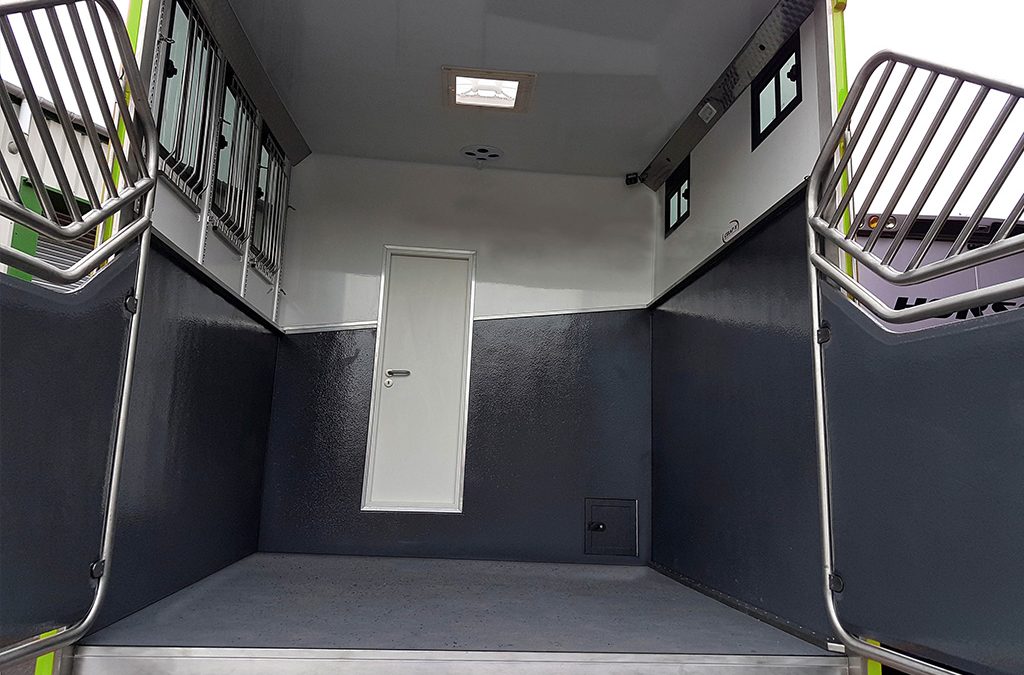Horsebox safety
One question that pops up often is whether we could manufacture light horsebox partitions and even if I would manufacture them in aluminium. The answer is we already have produced aluminium horse partitions, but for very specific builds and always with horsebox safety coming first. I can only speak for our own horseboxes with any authority, but the principals apply to most in varying degrees and I feel a small amount of clarification is needed to answer this satisfactorily.
For KPH horseboxes we have designed our safety features around heavy braking and a worst case collision scenario. Our two horsebox models differ greatly in the way the horses are stalled to the direction of travel. The direction of travel to the stalls is the key to a safe design and in turn this has a large impact on the materials that are suitable for the horse partitions. There is actually far more to our design and safety planning than simply the horse partitions. For the Aeos and Helios models we have designed a double skinned structural safety cell around the horses and this forms the secure hanging point for the horse partitions. The safety cell not only adds structural strength, it adds a cavity and a complete second wall between the horses and the outside world.
It would be easy to take a horsebox and look at only the heavy parts with a view to replacing them with lighter materials like aluminium. However the facts are that safety should take precedence over every other consideration. At KPH we have many years of materials experience and technical knowledge backing up our designs. We know all too well that aluminium is not a cure all material. Horse safety and customer safety are our design priorities and this applies to our new or used horseboxes alike.
Many factors make a horsebox accident different than other smaller vehicles with less weight. For example, they have longer stopping distances, greater weight and heavy, relatively unsecured loads. Horse partitions are just one example where no compromise between weight and strength is acceptable. If in doubt my advice would always be to ask for pictures of these key parts before you buy. Preferably visit the manufacturer and look at the construction before its hidden away in the build process! This is an area where we are only too happy to walk customers around our clean workshops and show the details of construction and work in progress.
Both Helios and Aeos models have been designed with shear stress as a high priority. Shear stress occurs when an applied force (accident impact) is parallel to the body. In the event of a horsebox accident this would be visible as tears in the sides around bolts or screws (horse tie rings or bolts through the centre bulkhead). At the design stage for both models we removed all external bolts and screws and opted for the much stronger adhesively bonded manufacturing process. This design not only increases strength but adds much improved aesthetics and longevity. It also reduces vibration and sound by up to forty percent.
Small Horseboxes
With horsebox safety at the fore, the 4.5 tonne Aeos horsebox range has excellent payloads of up to 2 tonnes. For this Aeos version we have opted for strength and longevity with tubular stainless steel horse partitions and Coat-X protected padding as standard.
At 3.5 tonne on the lighter Aeos range customers have a choice between tubular stainless steel and aluminium partitions. This is possible because on the Aeos range the horses face the rear of the horsebox. In the most common accident from the front, the momentum of the horse would transfer into the bulkhead behind the driver where we have a double skinned reinforced safety bulkhead over 100mm thick mounted on cab structural points. If you consider that the weight of a horse can double or triple in a collision, you can see the importance of strength when a horse stands behind the drivers head. Even though the reinforced safety bulkhead adds many unwanted kilograms to the build, it is a no compromise item for us as safety comes first. As a little added safety touch we thoroughly soundproof the reinforced safety bulkhead too.
Larger Horseboxes
For the 7.5 tonne to 26 tonne Helios range of horseboxes, stronger stainless steel horse partitions are necessary because the horses stand herringbone and side-on to the direction of travel. In the event of a front or even rear collision the momentum of the horse is transferred directly into the horse partitions. To take this amount of impact a horse partition made of aluminium would need to be 75mm to 100mm in width and very thick material, so not practical at all for horseboxes of 7.5 tonne and over.
For the Helios horsebox range a large part of our horsebox safety and structural design is based around transferred momentum in the event of an accident. Super strong horse partitions are only half of the equation for horsebox safety as the load weight (horses) is transferred in an impact firstly into the horse partitions and secondly through the horse partition mounting points into the safety cage. The Helios horsebox manufacturing process takes this impact transference into account. At the subframe stage we incorporate a stainless steel safety cage that encompasses the horse area. For strength and added safety it is welded to the rear ramp frame and the centre bulkhead partition. Much like the Aeos design we have double skinned walls around the horses.

